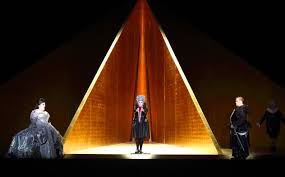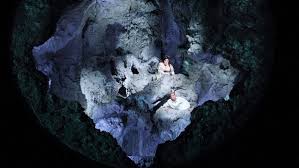London Coliseum, Thursday 9 June 2016
Wagner productions have almost priced themselves out of the market, so we have to treasure them when they do come along. If ENO are still somewhat under a cloud, the new Tristan and Isolde should go a good way towards restoring morale. Though not perfect – what Wagner production could ever be? – there are so many good things going for it they far outweigh any smaller niggles. For Daniel Kramer this was baptism by fire. Not only was he directing a major opera for the first time at ENO, this was to be his first work since being appointed Artistic Director. That he comes out of it with considerable aplomb is a tribute both to himself and the company. The highest compliment to pay has to be his sensitivity to the score itself. Nothing he asks of his soloists gets in the way of the music or the text. Where so many modern productions are intellectually or politically apt, they too frequently do so at the expense of the score. Daniel Kramer always allows his singers to explore the characters and to communicate them through the music. Even where we may disagree with the approach – and the Waiting for Godot overtones for Kurvenal are certainly challenging – the character is never asked to do anything out of kilter with the score.
He is fortunate to have some of our best singing actors to ensure his ideas are met. Stuart Skelton is as fine a Tristan as we can ask for today. A true heldentenor who has surprising levels of sensitivity and vulnerability without the need for unmusical extravagance in the voice. He has more than sufficient reserves for the final act, and his warmth in the love duet was most impressive. After fifty years of Tristan performances his is, in my experience, one of the finest and we are lucky to have heard him.
If Heidi Melton has yet to find the full flowering of Isolde she certainly made a fine start. Her attack and vitriol in act one were superb and she warmed to Tristan in act two without becoming over harsh at the top of the voice. Surprisingly the Liebestod was underpowered but this may have been first night nerves.
There were no smaller parts on this occasion. Craig Colclough was a rugged Kurvenal even if his characterisation was unexpected. The third act was particularly moving as he became almost the faithful guard dog to his wounded master. Karen Cargill’s Brangane was superb throughout, and I am waiting for the BBC broadcast to focus on her warning as it was somewhat upstaged by the visual effects during the love duet. Matthew Rose was un-necessarily aged but sang with middle-aged authority even when surrounded by beds and superfluous medical staff at the end of act two.
The orchestra under Edward Gardner were superb, the strings particularly effective in weight and depth. At the end of the evening there were cries of Come back as he took his curtain call. You may think that – I couldn’t possibly comment.
If I have left Anish Kapoor’s designs and the video design to the end it is essentially because so much has been written about them already. I was fortunate enough to be sitting centrally so had no problem with either sight lines or acoustic, but I accept that those at the sides had a very different experience from those of us fortunate enough to see the whole stage. There has not been a good history of artists working for stage design – David Hockney being very much the exception – so I have to admit to being initially concerned. His designs certainly work well and give a monumental sense of place. The only surprise is act three, where a grey drop curtain in front of the massive cave-like structure of act two is all we have. That the act works so well is down to Stuart Skelton’s singing and Daniel Kramer’s sensitive direction.
And what happens at the end? Many years ago I recall a Peter Hall production in which Tristan rose again behind Isolde. It was a thrilling, magical, moment. But what is happening here? After an evening almost obsessed with drug taking (essential to the plot so not in itself a problem) and madness, we seem to be given the most naturalist and yet optimistic of endings. Both Tristan and Isolde have long grey hair. The servants are equally old even if Mark is unchanged. Tristan retreats into the act two cave, where Isolde appears, equally grey haired. She then appears to die of a heart attack. So what is the Liebestod? It appears to be the continuation of love after death, overcoming the potential impact of drugs and society. If this is what Daniel Kramer intended it is wonderfully effective. I only hope we get a chance to see the production again once he has had time to smooth out the minor problems. With him in charge maybe ENO has turned a corner.


